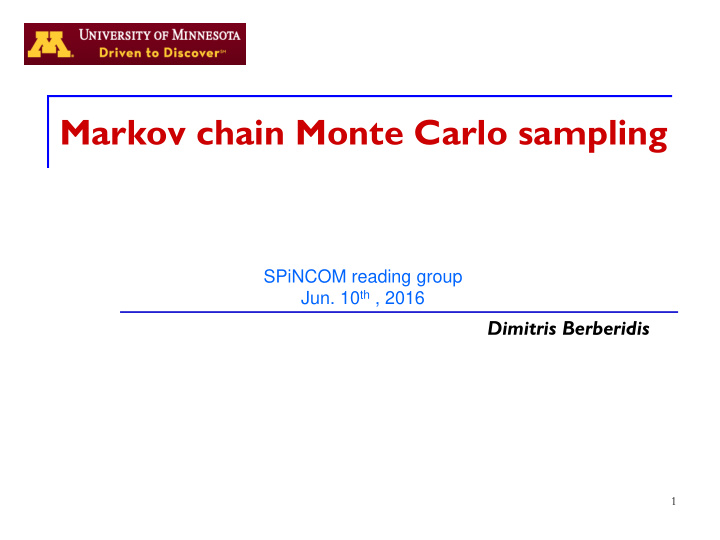



Markov chain Monte Carlo sampling SPiNCOM reading group Jun. 10 th , 2016 Dimitris Berberidis 1
Problem statement - Motivation Goal : Draw samples from a given pdf Impact of sampling : Bayesian inference ( :unknowns, : data) Normalization Marginalization Our focus Expectation Optimization: non-convex multimodal objectives Statistical mechanics Penalized likelihood model selection Simulation of physical systems 2
Roadmap Motivation Basic Monte Carlo Rejection Sampling Marcov chain Monte Carlo Metropolis-Hastings Gibbs sampling Importance sampling Relation to Rejection Sampling Sequential Importance Sampling (Particle Filtering) Conclusions C. Andrieu, N. de Freitas, A. Doucet and M. Jordan, “An Introduction to MCMC for Machine Learning,” 3 Machine Learning , pp. 5-43, Jan 2003.
The Monte Carlo principle Draw samples i.i.d from Approximate with Approx. integrals with tractable sums unbiased for finite with with Approx. the maximum of as Challenge: What if does not have a standard form (e.g. Gaussian) ? 4
Rejection Sampling Instead of , draw i.i.d samples from an “easy” Proposal pdf should satisfy: Rejection Sampling algorithm Accepted sampled according to Severe limitation in practice: can be too large 5
Basics of Markov chains Discrete stochastic process is a Marcov chain (MC) if MC is homogeneous if is time invariant After steps, probability of state is: MC reaches stationary distribution if : MC converges to a stationary distribution if Irreducible: All states are visited (transition graph connected) Aperiodic: Does not get trapped into cycles 6
Markov chain Monte Carlo Goal : Construct MC with target as stationary distribution Sufficient condition: The detailed balance condition (DBC) Continuous states Transition kernel: DBC remains the same Run MC to convergence and obtain non i.i.d samples Design to achieve fast convergence (e.g. small mixing time) 7
The Metropolis-Hastings sampler Rejection probability MH transition kernel: satisfies DBC Admits as stationary dist. Scale of not needed! (recall ) MH always aperiodic; irreducible if support of includes support of Special cases of MH Independent sampler: Metropolis sampler: 8
Example of MH sampling Three different Gaussians as proposal distributions Choice of proposal distribution is critical! 9
MCMC with mixture of transition kernels Key property Let and trans. kernels converge also converges to Intuition Local random walk reduces the number of rejections Global proposal helps discover other modes 10
Example of MH with mixture of Kernels Target: Proposal: 11
Experiment with mixture of Kernels 12
Simulated Annealing Simple modification of the MH algorithm for global optimization Example Simulates a non-homogeneous MC with Intuition: concentrates around global max. of as 13
Experiment with Simulated Annealing 14
Cycles of MH kernels Multivariate state is split into blocks Each block is updated separately Transition Kernel Block correlated variables together for fast convergence Trade-off on block size Small block size: Chain takes long time to explore space Large block size: Acceptance probability is small 15
Gibbs sampling For assume that we know Gibbs sampling proposal distribution Acceptance probability =1 Combined with MH if not easy To sample Markov networks, condition on ``Markov Blanket’’ 16
Importance sampling - Basics Key idea: sample from and weight with Draw i.i.d from to obtain: Target is approximated by Estimate is unbiased and: If scale of unknown, set and normalize 17
Efficiency of importance sampling Proposal pdf selected to minimize variance Variance lower bound (using Jensen’s ineq.) Optimum importance distribution IS can be super efficient! Generally difficult to sample 18
RS as a special case of IS Recall the rejection sampling method Define a new target distribution in IS with target and proposal Equivalent to RS if samples are used to obtain IS generally (and provably) more efficient for this purpose Y. Chen, “Another look at rejection sampling through importance sampling,” Statistic & Probability 19 Letters, pp. 277-283, May 2005.
Hidden markov model The hidden Marcov model State transition model: Observation model: Goal of filtering : Approximate and 20
Sequential Importance Sampling (particle filtering) Target density: Importance density: Leave the past How to sample from ? unchanged At time we have: Sample for : Importance weights : Augment without changing the past (filtering) 21
Particle degeneracy – How to fix it Theorem: The unconditional variance of the weights (with interpreted as r.v.’s) increases with time. Proof . The weight sequence is a Martingale random process Martingale definition: Variance of a martingale is always non-decreasing Rao-Blackwell Theoretical fix: Sample from optimal Practical fix : Resample particles after each iteration A. Kong, J. S. Liu, and W. H. Wong, “Sequential imputations and Bayesian missing data problems,” J. 22 of the American Statistical Association, pp. 278-288, March 1994.
The particle filter with resampling Many available methods for selection (resampling) Simplest is to ``clone ‘’ w.p. Particles that are not cloned are ``killed’’ 23
The bootstrap particle filter Simple, non-adaptive proposal distribution Convenient for non-linear models with additive Gaussian noise Transition prob. and likelihood are both Gaussian (easy to sample) Simple to implement; Modular structure; Adheres parallelization Resampling is very critical! Ensures that the particles ‘follow’ the target A. Doucet, N. de Freitas and N. Gordon, “Sequential Monte Carlo Methods in Practice,” Springer , 2001. 24
Example: target tracking State: position and constant velocity Speed corrections (Gaussian noise with cov. Q) 25
Distance and bearing measurements Uncorrelated Gaussian noise 26
Tracking Bootstrap PF with particles: Sampling step (propagation of particles) Evaluation of weights (likelihood of particles) Randomized resampling w.p. 27
Result 28
Conclusions MCMC and IS: powerful, all-around tools for Bayesian inference Applicable to any problem if tuned properly Proposal distributions Resampling schemes (in PF) Other MCMC derivatives MCMC expectation-maximization algorithms Hybrid MC Slice sampler Reversible jump MCMC for model selection 29
Recommend
More recommend